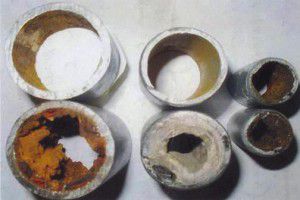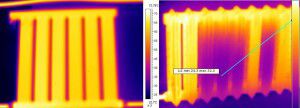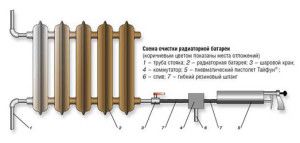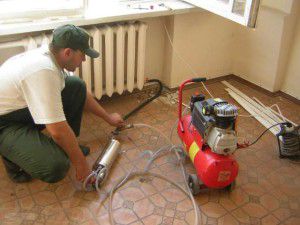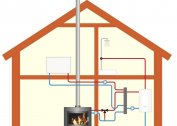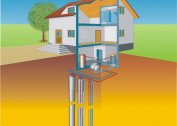Throughout the entire period of operation, contaminants accumulate in the pipes and radiators of the heating system. They negatively affect performance and can lead to serious problems. Therefore, the question arises before the owner - how and with what to rinse the home heating system: radiators, batteries, pipes? After all, the quality of the entire heat supply of the house will depend on this.
Reasons for clogged heating pipes
The composition of water includes many additional components. Most predominantly iron, calcium and magnesium. When exposed to relatively high temperatures, they are released in the form of small fractions that settle on the inner surface of pipes and radiators.
Therefore, before flushing aluminum radiators, you need to find out the nature of the pollution. In addition to calcium and magnesium deposits, oxide deposits can occur due to the natural rusting of the metal components of the heating system. Depending on the nature of the contamination, the optimal cleaning technology is selected.
Typically, plaque contains the following elements:
- Iron oxides. In a system with steel pipelines and radiators, they can occupy up to 25% of the total plaque;
- Deposits of calcium and magnesium - occupy up to 60%;
- Oxides of copper, sulfur and zinc - up to 15%.
Since the heating radiator in the apartment should be washed only after a preliminary analysis of the nature of the pollution is carried out, it is recommended to take a plaque sample first. To do this, you can dismantle part of the pipeline. In practice, this is not always the case, especially for heating systems installed relatively recently.
The frequency of flushing the heating system depends on the composition of the coolant, the temperature mode of operation, as well as on the materials for the manufacture of pipes and radiators.
Diagnostics of the heating system
How to rinse an aluminum radiator and when to do it? First of all, it is necessary to determine the appropriateness of the procedure for cleaning the system. It depends on several factors that can be identified independently.
The main sign of the relevance of resolving the issue of how to flush the heating system in an apartment building is the uneven heat transfer of radiators. Those. in some areas, the heating temperature is normal, while in others not. The relevance of washing the heating batteries can be determined by touching (which is not entirely correct) or using a thermal imager and turned thermometers.
Since it is possible to flush the heating system in a private house only after comparing its current indicators with the required ones, you should check the pressure in various parts of the circuit. In places of clogging of pipes and radiators, the wire diameter decreases, which entails pressure surges. This is also one of the factors of mandatory cleaning.
What other external signs may indicate a blockage?
- The increased noise level. It is a consequence of changes in the volume of passage of hot water in various parts of the system;
- Frequent operation of the safety group - air vent and bleed valve.
Having found out that it is necessary to flush the heating system in a private house, you should choose the right technology. It depends on the material of the manufacture of pipes and radiators.
Regardless of the above signs, the heating system must be cleaned at least once every 5-6 operating seasons.
Methods for flushing the heating system
Before flushing the heating system, you should choose the best way to clean the pipes and radiators from blockages. One of the problems is the density of the scale, which most often has a homogeneous structure located on the inner surface of the heating devices.
Therefore, before washing the cast-iron heating radiator, this deposit should be destroyed, breaking it into separate components of small dimensions. Then, with the help of a fluid flow, they are removed from the heating. This process is complicated if the components of the heating system are made of various materials - metal, polymers. Traditional chemical cleaning may damage some of them. Therefore, it is advisable to choose a method of mechanical impact on the scale.
Hydrodynamic flushing of heating
This is one of the most laborious methods to remove contamination. Its essence lies in the impact of a shock wave of water on deposits. This requires special pumping equipment, nozzles and a hose for supplying fluid.
The hydrodynamic method can only be used for pipelines or radiators with a simple arrangement of water channels. How to wash heating pipes with a long length? The use of chemical compounds will not be economically advantageous due to the significant volume of the system. Therefore, in such cases, the scale is removed mechanically.
This procedure is performed according to the following scheme:
- The coolant is removed from the lines.
- Areas for flushing the heating system in an apartment building or cottage are determined.
- A pipe section is dismantled and a hose with a nozzle is introduced into the line.
- Water is supplied under pressure, which destroys the scale.
After this, the system is filled with water and washed several times to remove residual scale. Before this, all internal filters must be removed. To prevent contamination particles from remaining in the system.
But how to wash the radiators if their internal configuration has a complex shape? The above method is not effective in this case. Therefore, you need to choose another, alternative.
For heating with a small length of highways, the hydrodynamic method can be advisable only if there are large solid deposits on the surface of pipes and radiators.
Chemical flushing of heating
Flushing heating radiators in an apartment is best done using chemical reagents. They act on scale, destroying it and crushing it into individual components of small sizes.
To flush the heating system in a private house, you need to choose the right composition. Some of them can destroy aluminum or polymer pipes. Therefore, before purchasing, you should read the instructions from the manufacturer.
For self-cleaning of heating, you will need a pump and a container for liquid. These devices with the help of pipes are connected to the highway. This can be done both on a separate site, and on the entire system as a whole. For many chemicals, you must first dilute the composition with water. After completion of the preparatory phase, the washing procedure of the heating system in a private house is carried out according to the following scheme:
- Coolant drain from the network.
- Filling the treatment plant tank with prepared chemical composition.
- Turn on the pump and fill pipelines and batteries with cleaning fluid.
- It usually takes 2–3 hours to expose and dissolve the scale.
- Reusable fluid circulation in the system. It is carried out until deposits are observed in the tank filter.
After flushing the aluminum heating radiator and pipes, the system is cleaned with water to remove chemicals.Then the heating is pressed and checked for leaks.
The cost of washing aluminum heating batteries depends on the composition and manufacturer. For a small system, it is recommended to purchase ready-made liquid, and for stand-alone systems - a concentrate that must be diluted with water.
| Title | Application features | price, rub. |
| DOCKER THERMO, 1 kg concentrate | Do not use for aluminum | 180 |
| Metalin T, 1 l., Concentrate | For non-ferrous metals | 105 |
| Master Boiler Power, 0.6 kg, concentrate | For all types of pipes and radiators | 475 |
If there was antifreeze in the system - before chemical cleaning it is necessary to rinse the pipes first with water 2-3 times.
Pulse pneumatic flushing of heating
With its help, you can rinse aluminum radiators without fear of destroying their surface. This is a relatively new method, which requires special equipment and experience in its operation.
The principle of cleaning the heating batteries is a short-term pulse effect on the hydraulic medium - water. This creates a pressure of up to 12 atm, with a shock wave velocity of about 1400 m / s. This will be enough to flush the heating system, regardless of its configuration. This technique allows you to remove plaque in long lines without dismantling individual components.
However, before flushing the heating radiator, it is necessary to familiarize yourself with the features of pulse hydraulic cleaning:
- The maximum pipe diameter is 4 inches;
- Effectively removes blockage even at a distance of 60 meters from the installation of an impact ram;
- Practically does not affect the integrity of the heating installation assemblies - fittings, threaded and welded joints.
To flush a cast-iron heating radiator in an apartment building, it is necessary to first block the flow of coolant in this section of the highway. This can be done without permission from the management company if there is a bypass in the battery harness. Then, a hydraulic ram is installed in one of the nozzles and several cleaning cycles are performed.
Timely flushing of the heating radiator will increase its heat transfer by 20-25%. Those. actually restore this figure to a normalized factory.
Self cleaning heating
Can I wash the heating pipes with my own hands? To do this, you need to conduct a preliminary analysis of the degree of contamination of the highway. Most of the scale is formed in the zone of maximum thermal impact - in pipelines located closest to the boiler. It is here that most often aluminum heating radiators need to be cleaned.
If the system has not been cleaned for 15-20 years, it is recommended to dismantle the radiators and the boiler heat exchanger. In this way, you can most effectively flush the heating system in a private house. To do this, you do not need to remove the pipes - just temporarily dismantle the batteries.
Then you should choose equipment for washing the heating system. Since this procedure is rarely performed (once every 5-6 years), it is best to rent a pumping station. During the cleaning process, it will be necessary to drain contaminated water. A sealed container should be used for its temporary storage. This is relevant when washing iron cast-iron radiators, in which the most accumulated scale during operation.
Then the tank is filled with already diluted concentrate of the cleaning liquid. The pump nozzles are connected to the battery, and several purifier circulations are performed. They continue until there are no scale components in the filter. A similar scheme for flushing heating in a private house is carried out in the summer - during this period there is no coolant in the system.
After flushing the heating pipes, it is recommended to check the condition of the connecting elements - threaded or clamping fittings.They may also have rust or plaque. If cleaning is not possible, replace the component with a new one.
The video shows an example of flushing a heating system in a public building.
